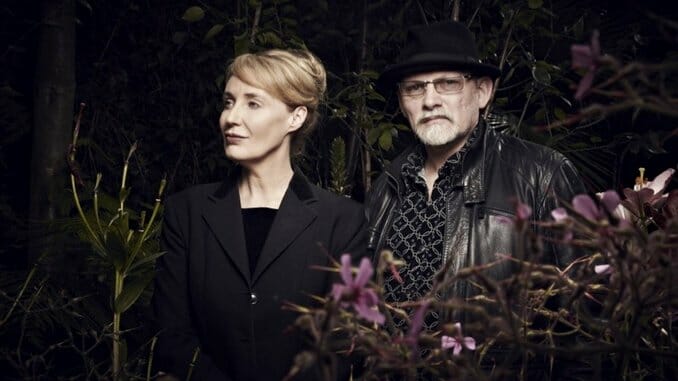Dead Can Dance: Celebrating the Spirit of Dionysus

Despite mounting evidence to the contrary, keen-eared Dead Can Dance founder Brendan Perry swears that he hasn’t become a monomaniacal, house-cramming hoarder of arcane musical instruments. Yet. “But it is getting ridiculous,” allows the Brit, who now resides in France but first formed his ethereal outfit with vocalist Lisa Gerrard in her native Australia back in 1981.
“The wife just looks up at the heavens every time that UPS arrives with another new instrument, so my collection is growing with every new project.” To wit, the duo’s latest ambitious undertaking—a two-act, seven-movement concept album called Dionysus based on the Greek god’s multi-faceted pagan persona, which was once vilified by both Christianity and Islam—features all of these disparate Perry-played devices, in order of appearance: zouma, gadulka, autoharp, bowed psaltery, davul, ocean drum, saz, pivana, daf, aztec flutes, rainstick, bird whistles, berimbau, gaida, balalaika, gong, fujara, baglama, zils, zitherm harp, and—of course—a good old-fashioned stone.
A sonic perfectionist, he knows exactly when and where to use each delicate tool to tell his historical tale, from the opening “Sea Borne” (wherein the outsider Dionysus arrives by ocean) through “Liberator of Minds” (which explores his more hallucinogenic aspects), “The Invocation” (which summons him to the annual harvest festival, “The Forest” (underscoring his back-to-nature message), to a closing “Psychopomp,” exploring his additional role as a guide to the afterlife. While Gerrard adds her otherworldly voice to “Psychopomp” and “The Mountain,” the credits say it all: Dionysus was performed, recorded, produced, engineered, and mixed by Perry himself, with such a meticulous attention to detail that nothing but the most evocative instruments would do.
And—nine albums into its classy career—fans would expect nothing less from this team, which has been forced to postpone its spring tour in the wake of the current coronavirus pandemic. But Perry was more than happy to explain the method behind his madness in the interim, and the lengths to which he’ll go to achieve the soundscapes that he envisions.
Paste: Where do you find all these instruments?
Brendan Perry: Well, to give you an instance, I’m working on an album of old Greek songs, and in pursuit of that, I have to be as authentic as possible in the instrumentation. So I’ve kind of acquired a lot of different instruments for it, like family bouzoukis, tzouras, a santouri. Just working on this one project, I’ve ended up with seven new instruments. And that’s the way it’s gone over the years—whenever I’ve gotten into a certain genre of music, I tend to research the instruments and see it right through. And I always end up with a lot of new instruments, per each adventure.
Paste: Which ones have surprised you the most, sound-wise?
Perry: That’s a tricky one. It wouldn’t be stringed instruments so much because I pretty much know what to expect from them. Hmmm. Probably it was the yayli tambur, which is a Turkish bowed instrument with a long neck. It has a kind of banjo resonator body, so it’s got a bit of reverb in the sound—it’s got a kind of metal bowl that works with the long neck as a resonator. But really the ones that often surprise me are the synthetic instruments, and the one that really is quite special that I’ve acquired over the last few years is a keyboard with a synthesizer built into it, and it’s called a Haken Continuum Fingerboard. But the fingerboard itself doesn’t have conventional keys—the keys are painted on the kind of material you have in skindiving suits, neoprene. And it’s touch-sensitive, so when you press in, it gets louder, but it doesn’t have a 12-note tempered scale. It can be free-form, so you can get into micro-tones between the notes and do slides and things. And that’s pretty remarkable, because the actual playing of the Haken is very much just half the equation. It’s your expressiveness and the way that you can work with this neoprene surface that’s pretty amazing.
Paste: Do you scour eBay to find these items?
Perry: Yeah, I do use eBay a lot for older instruments. For quality vintage instruments, I tend to always go to eBay. But for new instruments, generally the hardest things to find are the electronic units that they only made so many of, like effects units for the studio. You can always find the instruments, if you’re willing to pay the price. But with electronic instruments, and classics like the Marshall amp, it isn’t the amp itself—it’s the Marshall modulator, which was something that Martin Hannett, for instance, used on all of his productions. And this modulator, this machine, you find them occasionally, sometimes not working, for about two and a half thousand, And they’re not even working! So things like that are really, really rare. It’s only a question of just sitting there and waiting, and eventually they’ll turn up.
Paste: Have you ever traveled to some exotic land for your collection?
-

-

-

-

-

-

-

-

-

-

-

-

-

-

-

-

-

-

-

-

-

-

-

-

-

-

-

-

-

-

-

-

-

-

-

-

-

-

-

-








































